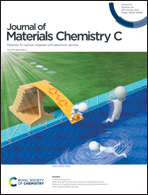A high-performance NiO/TiO2 UV photodetector: the influence of the NiO layer position†
Abstract
p–n Junctions have been widely used in the construction of high-performance TiO2 ultraviolet photoelectric detector devices, especially NiO/TiO2 heterostructures. In this work, two devices with different structures were constructed to investigate the effects of the growth of NiO above (S-TN) and below (D-NT) the TiO2 array on the device performance, and the D-NT device showed better performance. The D-NT device exhibited a lower dark current, with a decrease of approximately an order of magnitude compared with S-TN PD and TiO2 nanoarray (NA) PDs. The D-NT heterojunction device demonstrated a large on–off ratio of 5.4 × 104, a high detection sensitivity of 1.44 × 1014 Jones, and a fast photoresponse time of 2 s under UV light illumination. Interestingly, the D-NT device also displayed self-powered performance, and its photoresponse time was 0.1 s. The dense and uniform NiO film deposited on the FTO substrate not only forms a built-in potential field with the TiO2 NAs, but it also provides greater uniformity and stability to this built-in potential field compared to a NiO layer spin-coated on TiO2 NAs, which may be the main reason for the high performance of the D-NT photodetector. The device in which NiO was grown below the TiO2 array provides a fundamental basis for the future development of all-solid-state photodetectors.



 Please wait while we load your content...
Please wait while we load your content...